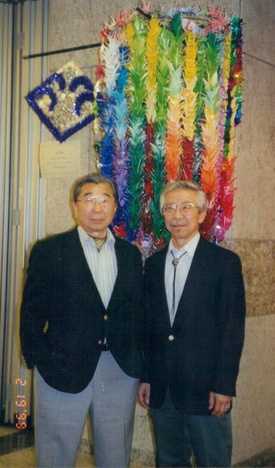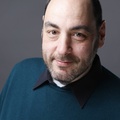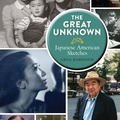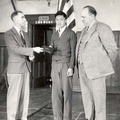“Let me add, however, that in refusing to register, I am well aware of the excellent qualities of the army and government personnel connected with the prosecution of this exclusion order. They are men of the finest type, and I sincerely appreciate their sympathetic and honest efforts. Nor do I intend to cast any shadow upon the Japanese and the other Nisei who have registered for evacuation. They have faced tragedy admirably. I am objecting to the principle of this order, which denies the rights of human beings, including citizens.”
—Gordon Hirabayashi, May 13, 1942
This ability to separate the objectionable policies from the people administering them illustrates Gordon’s remarkable maturity and thoughtfulness at a young age. Gordon, of course, is historically famous because of the US Supreme Court case, Hirabayashi v. US, which was rooted in his defiance of the curfew and mass removal of Japanese Americans on the West Coast during WWII.
Thanks to a legal team headed by Peter Irons in the 1980s, and a relatively obscure writ of error coram nobis legal claim, Gordon’s wartime conviction for defying the curfew order was vacated. Also, he was posthumously awarded the Presidential Medal of Freedom in 2012.
Gordon’s nephew and younger brother—Lane, a UCLA professor; and Jim, a professor emeritus at San Francisco State, respectively—worked tirelessly to publish A Principled Stand (“APS”) to “complement the many publications that examine Gordon’s court cases.” Furthermore, while most of the available literature focuses on the legal aspects of his resistance, APS is unique because it focuses on Gordon the person. Specifically, the book intends to convey what was going through Gordon’s mind at the time, using his own accounts wherever possible. Plus, it is replete with numerous photographs from family and friends, which only enhances the storytelling.
The book originated in a series of interviews and file collections that spanned over a decade. Jim recorded several interviews with Gordon dating back to the 1990s and as recently as 2008. Jim also collected extensive personal files stored in Gordon’s garage. It was Jim’s idea to use these “unpublished primary documents to convey Gordon’s thoughts and emotions during the 1940s.” Jim’s son, Lane, explained, “By 2009, Gordon was not able to write up his own story and so Jim felt it was his personal responsibility to draw from Gordon’s diaries, letters, and other writings, to generate the story using, as much as possible, Gordon’s own words.
But because Gordon’s papers were unorganized, Jim had to do a great deal of sorting and filing before and as he developed the narrative.” Jim soon invited Lane to join him in this effort, and “for three years they read, met, corresponded, and exchanged ideas on how best to carry out this task.”
At the risk of sounding redundant, what makes this book such a rare treasure among the volumes of Japanese American literature is that it is not based on interviews of Gordon’s recollections several decades after the fact; for the first time, the events that Gordon admirably endured in the 1940s are told in Gordon’s own contemporaneous words. “The book draws most heavily from Gordon’s prison diaries and letters.” His “personal letters include more than two hundred of his own letters as well as a number of letters he received from various correspondents.” Thanks to the tremendous father and son effort expended to generate the manuscript, eventually it was submitted to the University of Washington Press. From there, “it was largely Lane who massaged the text further in response to various comments.”
Upon digesting this book, readers will no doubt concur with Lane that reading a young Gordon’s account of what happened to him in the 1940s is like reading about it from a fresh, new perspective. Lane had “read many of Gordon’s papers and speeches over the years about his court cases and the events leading up to them. Most of these, of course, were written 30 or more years after the fact, when Gordon was much older, and when he could put things into a longer-term perspective.”
Lane further added, “What made a big impression on me, when I started reading the diaries and letters of the 24-year-old Gordon, was how fresh his comments were. It was like I was hearing the same voice, but in a much different register, with different kinds of insights than how the 60-year-old Gordon generally expressed things.”
From early on, Gordon’s parents, as well as the Japanese-Christian cooperative of which his family was a part, combined to act as the source of the fortitude and resolve Gordon exemplified in his principled stand during WWII.
Gordon acknowledged that the “greatest moral and spiritual impact came from [his] parents’ way of life. Their living example had to do with honesty and integrity in all aspects of human relations.”
He described his mother as the fire and his father as the anchor. His mother’s outstanding quality was her determination. To illustrate, Gordon recounts a great example regarding a Singer sewing machine and another of how his mother became vice president of the local Japanese association. As for his father, Gordon recalled how he used to complain that his father was too honest for a businessman because he “would insist on packing lettuce with good, beautiful ones in the bottom and middle, not just saved for the top layer,” to which his father would respond, “Honesty is honesty—besides I have to live with myself.”
Likewise, driven by their belief in a just cause and their faith in God, Gordon was convinced that the cooperative members’ fight against the State of Washington’s Alien Land Law was instrumental in planting the seeds of strength and guiding light that helped him confront the government during WWII.
Beyond immediate family and community, another organization that left Gordon with an indelible passion to stand by his principles was the Boy Scouts of America, where he described participating in its leadership conferences as “a springboard for [his] inclination to take first-class citizenship seriously in spite of the knowledge of second-class status of Japanese in the prewar days.”
As Gordon experienced life through high school into college, like many Nisei during that time, he struggled to balance Japanese and American cultures and values. As he gravitated toward the latter, two organizations provided profound, lasting impacts on Gordon’s views throughout his WWII trials and incarcerations: the YMCA and the Quakers (American Friends Service Committee).
The book details specific events, written in Gordon’s own words at the time, associated with those organizations that confirmed his unabashed fight for equality for all US citizens including Americans of Japanese ancestry. In fact, on his way home from a YMCA conference one summer, well before his WWII defiance, Gordon described taking a Rosa-Parks-type stand for his beliefs in the Carolinas where he came face to face with Jim Crow laws. In defiance of the laws, he sat in front of the bus, and although nothing really came of his stand, at the time of his decision, he was prepared for real consequences.
From there, the bulk of the book naturally follows Gordon’s experiences as he defied the curfew and mass removal orders during WWII. If for no other reason, everybody is strongly encouraged to read this book to take away for themselves how poised, collected, and determined he was at 24 years old. Frankly, it was a pleasant surprise to read about how principled he was at such a young age.
Lane essentially had the same reaction when he first started combing through all of Gordon’s old journal entries:
“I only saw [Gordon], at best, over summers when my family went up to Seattle every year until I was about 18 or 19. So reading into the thoughts and inner life of the 24-year-old Gordon was a revelation to me. I expected to find that Gordon was anxious or even depressed once he landed in King County Jail. I was surprised to find that he was so certain about the righteousness of his stand and that, on a day to day basis, he was so thoughtful, even upbeat.”
There may have been critics out there who questioned just how principled his stance may have been, as Gordon recollected those tragic life events in numerous interviews 40 years after the fact. But there is absolutely no denying his personal journal entries at the time he was experiencing those events in the 1940s.
There are too many examples to cite in this article, but the JA community and Americans in general owe a debt of tremendous gratitude for Jim’s and Lane’s diligence in organizing Gordon’s personal journals and letters, to humanize an iconic figure in American history.
* * * * *
Please join us on Saturday, September 21, 2013, at 2:00 P.M., as the Japanese American National Museum hosts author Lane Ryo Hirabayashi for a book discussion regarding his and his father’s work, A Principled Stand: The Story of Hirabayashi v. United States. For more information >>
If you are unable to make this book event, it is available for purchase in the Museum Store or online at http://janmstore.com/151379.html.
© 2013 Japanese American National Museum







